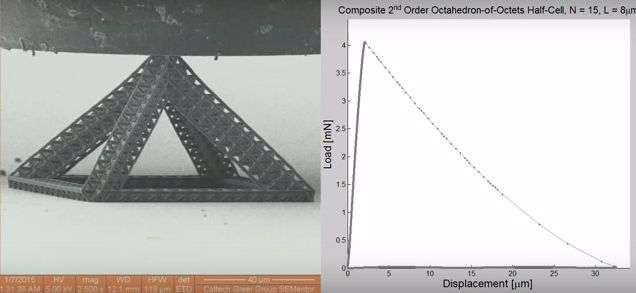Deformation of 3-D hierarchical nanolattices

In a new paper published in the Proceedings of the National Academy of Science (PNAS), researchers in the laboratory of Julia R. Greer, professor of Materials Science, Mechanical Engineering and Medical Engineering, have designed a new kind of hierarchical nanostructure that is stronger than previous lattice structures and bounces back with less damage after compression. Hierarchical engineered structures, like the Eiffel Tower, are designed like fractals, repeating patterns that are the same, or self-similar, at every level of magnification.
"It's basically a lattice of beams made of a lattice of beams, with the smallest dimension of about 10,000th of your hair diameter," says Lucas Meza, a fourth-year graduate student in the Greer lab and the first author on the paper. "That's called a second-order lattice. The more lattices of beams made of lattices of beams, the higher order the hierarchy gets."
Meza and his colleagues experimented with several versions of this architecture, with the results of these trials shown in these videos. The nanolattice made of hollow ceramic beams showed the greatest "recoverability," or bounce-back, even after being grossly deformed. This happens through a process known as shell buckling, in which the ceramic can crumple like a piece of paper under stress and then recover when the stress is removed.
On scales larger than nanometers, ceramic fails often from cracks and defects (a dropped coffee cup will demonstrate this effect). But at thicknesses of around 20 nanometers—the thickness of the shell of a hollow beam—ceramic approaches its theoretical material strength because the probability of finding a flaw or a crack in something that thin is significantly reduced. This represents the "true" amount of force a material can withstand if it has no defects. Although the lattice in the video is 99 percent air, its strength is comparable to that of foam structures that are more dense by two orders of magnitude.
More information: "Resilient 3D hierarchical architected metamaterials." PNAS 2015 ; published ahead of print September 1, 2015, DOI: 10.1073/pnas.1509120112
Journal information: Proceedings of the National Academy of Sciences
Provided by California Institute of Technology




















